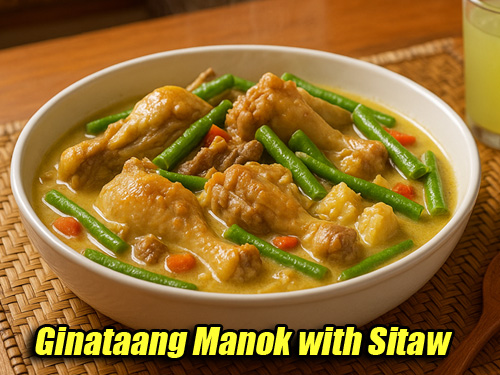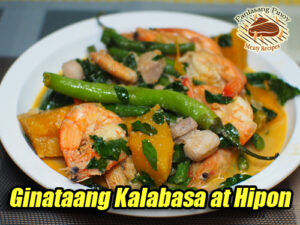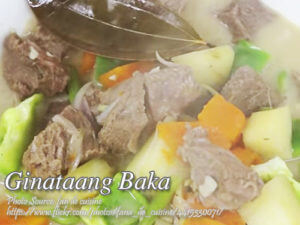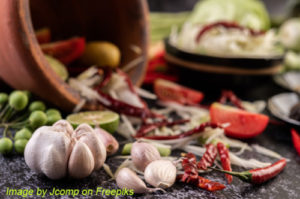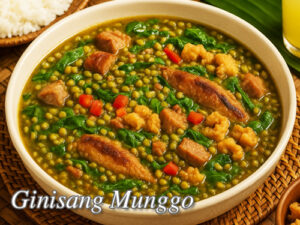Ginataang manok with sitaw is actually a ginataang manok dish with string beans or “sitaw”. This is one of the variation of ginataang manok or chicken with coconut milk that you can easily cook. Just boil the chicken with water, onions, garlic, salt and ginger until tender. Then add the coconut milk and boil it until the sauce is thick, then add the string beans until cooked and the sauce is oily.
Ginataang Manok with Sitaw: A Taste of Home in Every Bite
There are dishes that feed the stomach, and then there are those that feed the soul. Ginataang Manok with Sitaw is one of those meals that brings me back to childhood summers in Sorsogon, where the scent of ginger and garlic simmering in coconut milk would fill my Lola Miding’s kitchen by mid-morning. It’s a dish that has traveled through generations in our family—simple, hearty, and deeply comforting.
A Comfort Food Passed Down the Line
My Uncle Tonio, who prides himself on being the “official cook” during reunions, always swore by using native chicken for that rich, gamey flavor. He said it reminded him of the version their own mother used to make back when they still lived by the rice paddies. It takes a bit longer to tenderize, but the payoff is flavor that doesn’t get lost in the gata.
He taught me the most important rule of cooking chicken in coconut milk: patience. Letting the meat boil gently with aromatics—onion, garlic, ginger, a splash of calamansi juice, and salt—builds a base of flavor that coconut milk can cling to. It’s not rushed. You wait until the chicken absorbs every note before pouring in the creamy gata.
Why Coconut Milk Changes the Game
Coconut milk isn’t just a liquid ingredient here; it’s the heart of the dish. When simmered slowly, it thickens into a sauce that coats the chicken and seeps into every fiber. And when you see a little oil separating from the sauce? That’s when you know it’s done right.
In our home, we didn’t always have access to store-bought coconut milk. My cousin Leah, who now lives in Laguna, remembers how their family used to grate fresh niyog and press it by hand. It’s hard work, but the flavor difference is undeniable—a freshness that elevates the whole meal.
Adding Sitaw for Crunch and Color
Somewhere along the way, my sister Malou started adding string beans to our usual ginataang manok. She said she picked it up from a friend in Quezon who swore it made the dish feel more “complete.” She wasn’t wrong. Sitaw adds a beautiful crunch and a contrast of texture against the tender chicken and silky sauce.
Besides the crunch, it brings a vibrant green color to the pot—a sign that it’s not just tasty, it’s nourishing too. You drop the sitaw in during the last few minutes, just enough to cook through but still firm. Overcook it, and you lose the magic.
How to Cook Ginataang Manok with Sitaw
The steps are beginner-friendly, which is why this version is often one of the first Filipino dishes I recommend to friends learning how to cook. You start by placing the chicken in a deep skillet with onion, garlic, ginger, calamansi juice, water, and a pinch of salt. Let it boil until the meat is fork-tender and the liquid is nearly gone.
That’s your cue to pour in the coconut milk. No need to rush; keep it uncovered and simmer gently. The key here is to let it reduce slowly until you see the oil float on top—that’s your flavor telling you it’s ready. Only then do you add the sitaw. Let it cook until it’s bright and tender-crisp.
A Little Food for Thought
Ginataang dishes are a legacy of our agricultural roots. In provinces like Bicol and Quezon where coconut trees are abundant, cooking with gata is second nature. This method of braising meat in coconut milk isn’t just practical—it’s cultural. It reflects the resourcefulness of rural Filipino households, turning what they have on hand into something deeply flavorful.
Ginataang Manok with Sitaw may be a humble dish, but it carries with it the wisdom of generations who knew that the best meals are not always the most complicated. Sometimes, they’re the ones that remind you of home.
From My Kitchen to Yours
Whether you’re cooking for the first time or looking for something to warm a rainy afternoon, give this coconut chicken stew a try. Serve it over steamed rice, maybe with a side of chili if you’re like my brother Joel who can’t eat ginataan without a spicy kick.
And when that first spoonful hits—tender chicken, creamy sauce, a snap of sitaw—you’ll understand why this dish has stood the test of time. It’s more than a recipe. It’s a story served hot.
How to Cook Ginataang Manok with Sitaw
Ingredients
- 1 whole medium-sized chicken about 1 kilo
- 1 pc medium-sized onion sliced
- 1 head garlic crushed
- 1 Tbsp. ginger sliced
- 2 Tbsp. calamansi juice
- 1/2 cup water
- 2 tsp. salt
- 1 1/2 cup thick coconut milk
- 1 bundle string beans or sitaw cut in 2-inch long pcs.
Instructions
How to Cook Ginataang Manok with Sitaw
- Dress chicken and cut into serving pieces.
- Arrange chicken in skillet; add onions, garlic, ginger, calamansi juice, water, and salt.
- Let boil until chicken is tender and water is almost dry.
- Add the coconut milk and continue cooking uncovered until thick and oily.
- Add the string beans and cook a few minutes more until vegetables are done.
- Serve hot.
Notes
Cooking Tips:
Use Native Chicken for Deeper Flavor
If you want a richer, more authentic taste, go for native chicken (manok na tagalog) instead of broiler chicken. It may take longer to tenderize, but its firmer meat holds up better in slow cooking and absorbs the flavors of the coconut sauce beautifully. Just allow extra simmering time to get that fall-off-the-bone texture.Simmer the Coconut Milk Gently
Avoid boiling coconut milk over high heat to prevent curdling and losing its creamy texture. A gentle simmer allows the gata to slowly thicken and release its natural oils, which gives the dish its signature glossy finish. You’ll know it’s ready when the sauce turns rich and slightly oily on top.Add Sitaw Last to Keep It Crisp
Sitaw (string beans) should be added only in the final few minutes of cooking. This keeps the vegetable bright green and slightly crunchy, adding a pleasant contrast to the soft chicken and creamy sauce. Overcooking sitaw will make it limp and dull in color, so keep a close eye.
